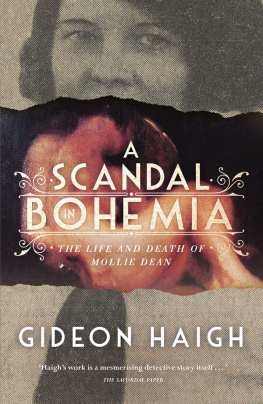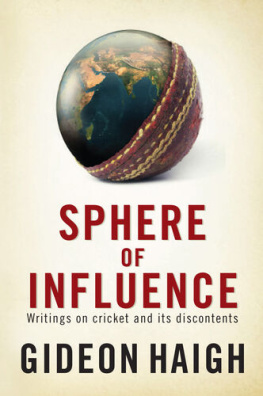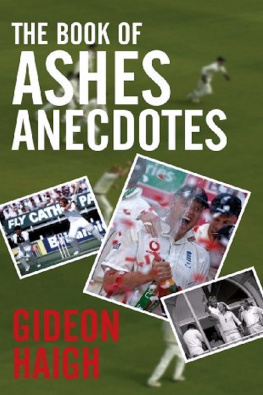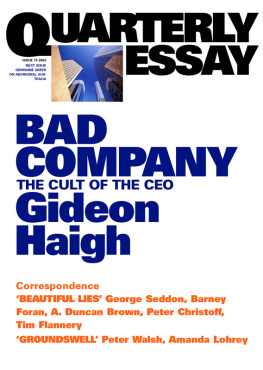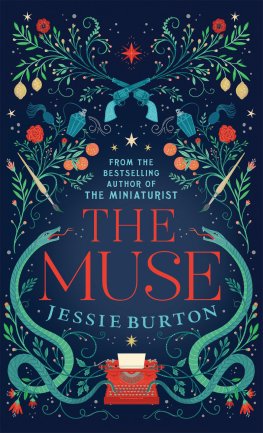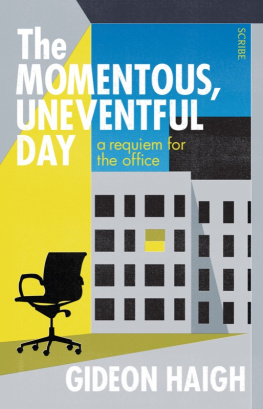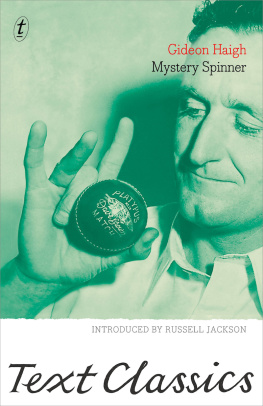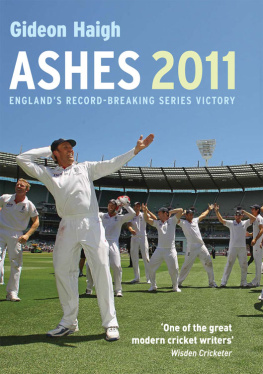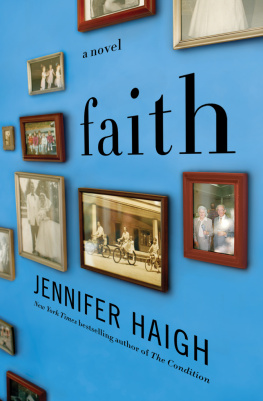About the Book
As enigmatic in life as in death, Mollie Dean was a woman determined to transcend. Creatively ambitious and sexually precocious, at twenty-five she was a poet, aspiring novelist and muse on the peripheries of Melbournes bohemian salons until one night in 1930 she was brutally slain by an unknown killer in a laneway while walking home.
Her family was implicated. Those in her circle, including her acclaimed artist lover Colin Colahan, were shamed. Her memory was anxiously suppressed. Yet the mystery of her death rendered more mysterious her life and Mollies story lingered, incorporated into memoir, literature, television, theatre and song, most notably in George Johnstons classic My Brother Jack .
In A Scandal in Bohemia , Gideon Haigh explodes the true-crime genre with a murder story about life as well as death. Armed with only a single photograph and echoes of Mollies voice, he has reassembled the precarious life of a talented woman without a room of her own. In this work of restorative justice, Mollie Dean emerges as a tenacious, charismatic, independent woman for whom society had no place, and whom everybody tried to forget but nobody could.
I only caught a glimpse of her at the moment, but she was a lovely woman, with a face that a man might die for.
I NTRODUCTION
For one who spent so much time surrounded by sharp-eyed artists and writers, Mollie Dean would prove a challenge to describe. She was very, very attractive, very beautiful, thought the painter Colin Colahan, and knew her power with men. She was not really beautiful but had a certain sultry charm, countered the playwright Betty Roland, being somewhat sullen-looking with a well-cut sensuous mouth. Passing moods lit her face from within: one writer thought her plain in repose; another evoked her dusky glow. A solitary photograph, widely published, is grainy and flat, lent character only by the eyes steady gaze and the jaws slight clench. Newspapers made up for its deficiencies with expressive prose: Five feet, six inches [168 cm] in height, dark bobbed hair, dark complexion, well-set determined-looking features, little or no powder on face, slim to medium build; A good conversationalist, she had a low speaking voice, an excellent thing in a woman. Her avowed preference was for the society of men older than herself a feeling that inevitably outgrows itself in time.

Sultry charm: Mollie Dean
The range of opinion reflected deeper ambivalence about Mollie Dean a young woman resolved to get places, a young woman who when she got those places was not always welcome. Who was she? What was she? She was an exceptional girl, the cartoonist Percy Leason told reporters. She had great vitality and charm and was particularly interesting. She was deeply immersed in literary questions and was writing a novel. I do not know what the novel was about. She was the sort of girl who would make light of such a work and not talk too much about it. Leasons confrre on The Bulletin , Mervyn Skipper, thought Mollie the first liberated woman he had ever met; Mervyns diarist wife, Lena, deemed Mollie a sex aggravator, a rum girl with plenty of that schoolgirl way about her hiding in all her actions some monstrously selfish aim. Roland complained that she had left a path of havoc in her wake.
All that most came to know of her directly was how that wake trailed away. For in November 1930, a month after her twenty-fifth birthday, Mollie Dean was slain in a laneway two minutes walk from her home slain so sadistically that the press refrained from comprehensively listing her injuries. Intensified grief, idealised potential these are the usual accompaniments of a tragically premature end. Not for Mollie. An investigation petered out that no-one, least of all the family from whom she was estranged, wished to revive; an inquest ensued, with an undertone of scandal it was in none of her friends interests to prolong.
As for her life, a good deal of Mollies adulthood had been spent in the fugitive role of the other woman, whose tracks are ideally self-obscuring. Her correspondence, purportedly racy, conveniently disappeared; likewise the manuscript for her novel, never finished. At Montsalvat, the Eltham art colony where many of her former circle settled, her name would be uttered only in muted tones. In art history, she has condensed to a curio. Misty Moderns , an extensive 2008 touring exhibition by the National Gallery of Australia, touched off a reappraisal of the artists with whom Mollie circulated the quasi-scientific, objectively minded disciples of tonalism such as Colahan, Leason, Justus Jorgensen, Clarice Beckett, Archie Colquhoun and, above all, their inspiration, the peppery controversialist Max Meldrum. Mollie was a line in the exhibitions genre chronology: November 1930: Murder of Colin Colahans girlfriend, Mollie Dean. Impact temporarily disrupts Colahans artistic trajectory. No reflection was invited on the permanent disruption of Mollies artistic trajectory.
Mollie Deans shadow lengthened by other means. She who had aspired to fiction inspired it instead affirming Edgar Allan Poes aperu that the death of a beautiful woman is, unquestionably, the most poetical topic in the world. Generations of Australians have been unknowingly familiarised with her story through the pages of George Johnstons My Brother Jack . Johnston never knew Mollie Dean; rather, more than twenty years after events, did he fall in with the gregarious Colahan, who became a friend and familiar in addition to painting Johnstons wife Charmian Clift. The murder had by now become part of Colahans extraordinary repertoire of stories; Johnston was transfixed. As his great novel took shape years later, he repurposed the relationship between artist Colahan and muse Mollie as the tale of star-crossed student painters Sam Burlington and Jessica Wray, who introduce Johnstons callow alter ego, David Meredith, to Melbournes la vie de bohme.
It is an atmospheric telling. Jessica is first glimpsed hastily fastening the buttons of her blouse, fair hair suggestively loose. She reacts to Merediths unexpected arrival at Burlingtons bachelor pad by saucily withdrawing: The blonde girl went away soon after I arrived. She and Sam talked together for a while in the passageway in low voices, with a lot of smothered giggling on her part, and I heard her say, But its high time I went home anyway, after the way youve been carrying on, you devil. Who is leading whom is rendered more ambiguous by Jessicas cavortings with other girls at an apartment party that further discomfits prim Meredith:
I remembered my alarmed revulsion at the shameless exposed way the girls sat on cushions on the floor, with their knees carelessly apart in their short skirts and the shadowy disturbing gleam of naked thighs above their rolled stockings. I was shocked by their casual acceptance of drinks and cigarettes, by the candour of their conversation, by their abandoned submission to kissing and petting.
The apartment is dominated by Sams not quite finished but extremely frank nude canvas of Jessica. Brother Jack, archetype of vernacular common sense, glowers at the painting disapprovingly when he arrives amid the bacchanal:

